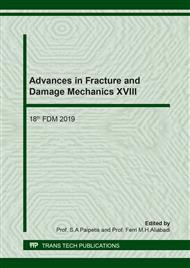p.318
p.324
p.330
p.336
p.343
p.349
p.355
p.361
p.367
Comprehensive Numerical Simulation on Thermally Grown Oxide and Internal Stress Evolutions in Thermal Barrier Coatings
Abstract:
TBCs (Thermal Barrier Coatings) is deposited on gas turbine blades to protect the substrate from a combustion gas flow. One of the serious problems occurred in gas turbine is TBC delamination which is caused by startup, steady and stop operation in service. TBC delamination results from subjecting to both cyclic thermal stress and evolution of internal stress due to thermally grown oxide (TGO). In this study, the finite element code which can simulate thermal and internal stress fields generated in TBC was developed. The developed code involves the follows: inelastic constitutive equation for ceramic coating, bilinear-type constitutive equation for bond coating and Chaboche-type inelastic constitutive equation for the substrate, and mass transfer equation in consideration of oxygen diffusion and chemical reaction with aluminum. Thermal cycling simulation was conducted using the developed code. It was confirmed that maximum stress and its location in the ceramic coating/bond coating interface were matched with the associated experimental results.
Info:
Periodical:
Pages:
343-348
Citation:
Online since:
December 2019
Authors:
Price:
Сopyright:
© 2020 Trans Tech Publications Ltd. All Rights Reserved
Share:
Citation:


